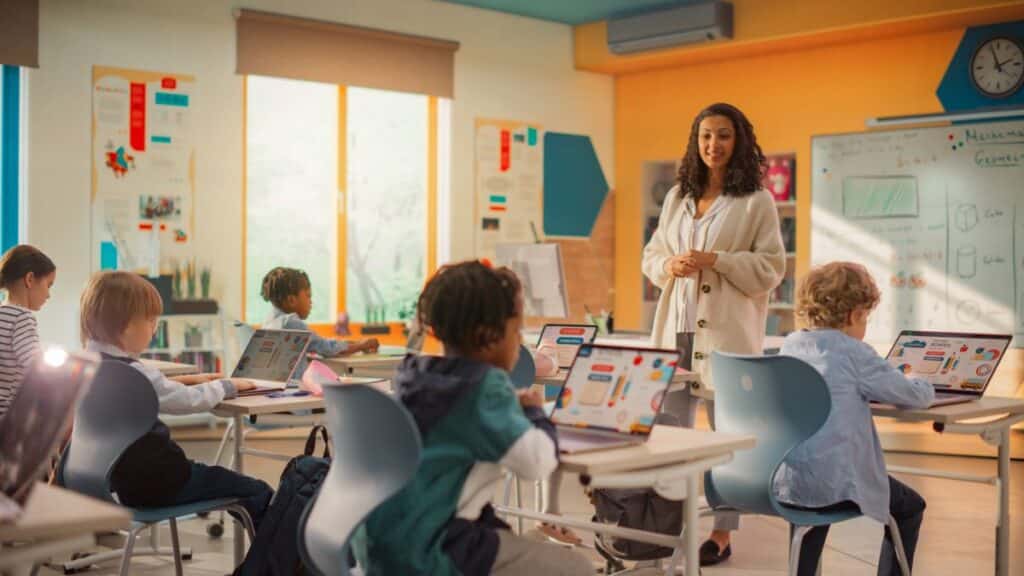Critical thinking is an essential skill for students of all ages, but it plays a particularly important role in the elementary years. This is when young learners start building the foundation for approaching challenges, solving problems, and processing information throughout their academic and personal lives. Teaching critical thinking in the elementary classroom doesn’t just help students excel academically—it empowers them to become independent thinkers, curious problem solvers, and lifelong learners.
Critical Thinking Skills That Elementary Students Should Learn
In the elementary years, students are beginning to learn how to problem-solve, make choices, and assess information. Here are some skills students at this stage should be working on.
Problem-Solving
Problem-solving is a process of considering different options, testing ideas, and reflecting on what worked and what didn’t. When students encounter a problem, they think is difficult, they should be encouraged to keep trying new strategies and reflect on the steps they took to solve the problem. It’s not just about getting the “right” answer but understanding the process of finding it.
Decision-Making
Learning how to make informed decisions is a key aspect of critical thinking. It is also especially important as students grow older and face more complex decisions. Giving students the tools to make responsible choices boosts their confidence. It prepares them for future challenges, and they feel more control over their actions.
Analyzing Information
Another important component of critical thinking is the ability to break down information and analyze it. Whether students are trying to solve a math equation or conduct a science experiment, understanding how to evaluate details carefully is essential.
Asking Questions
Fostering a sense of curiosity helps students go beyond just getting an answer to their question; it pushes them to uncover multiple layers of meaning. By promoting students’ inquisitiveness, you are showing them the world isn’t just made up of clear-cut answers. Asking questions allows students to dig deeper into their interests and become active participants in their learning.
Teaching Critical Thinking in the Elementary Classroom
Now that you know the essential skills elementary school students should be working on, now it’s time to incorporate critical thinking into your classroom curriculum. Here are a few ideas.
Use Real-World Problems
Students become more engaged in their learning when they see the relevance of what they’re studying. By showing them real-world problems, you give them a chance to apply their thinking skills in meaningful ways.
For example, let’s say you’re working on a unit about recycling. Instead of just discussing recycling’s importance, challenge students. Ask them to find ways to reduce waste at their school. Let them brainstorm, analyze options, and come up with a plan. This teaches critical thinking while also promoting collaboration and creativity.
Ask Open-Ended Questions
A simple way to encourage critical thinking in elementary school-age children is by asking open-ended questions. These are questions that don’t have a single correct answer. Instead of asking, “What’s 2 + 2?” ask “What are some different ways we could make 4?” This shifts the focus from getting the answer to exploring possibilities.
Encourage students to explain their thought processes. Why do they believe what they do? How did they reach their conclusion? What might happen next? This approach can be applied across subjects. For example, in reading, ask students why they think a character made a certain decision or how they would have reacted in the same situation.
Encourage Peer Collaboration
Group work can be a powerful tool for critical thinking. When students work together, they share ideas, listen to others, ask questions, and are exposed to different viewpoints. This kind of collaborative environment helps students practice their communication skills, explain their reasoning, and learn to negotiate their ideas. It also helps to foster a sense of teamwork and build their social and cognitive skills.
How Critical Thinking Skills Help Elementary Students Advance
Developing critical thinking skills in elementary school doesn’t just help students perform well academically but also gives them the tools to navigate real-life situations. Here are a few ways critical thinking helps students in the classroom and beyond.
Stronger School Performance
Critical thinkers excel at grasping complex ideas and solving problems. They can connect different subjects. They’re also more adept at tackling higher-order thinking questions on tests and assignments.
Increased Confidence
A critical mind boosts students’ confidence. It helps them tackle challenges. They understand that even if they don’t know the answer right away, they have the tools to figure it out. This way of thinking also encourages a growth mindset where students see a challenge as an opportunity to learn and grow.
Ability to Problem-Solve in Everyday Life
Critical thinking helps students assess situations, weigh their options, and make informed decisions. Whether they’re resolving disagreements with their friends or figuring out how to manage their time, these skills are essential for navigating everyday challenges.
Effective Communication
Strong critical thinking skills help students articulate their thoughts and opinions clearly, consider different perspectives, and engage in respectful, thoughtful discussions. Whether in the classroom or a social setting, students learn how to communicate in meaningful ways and actively listen to others.
Lifelong Learning
Critical thinking nurtures a love of learning. When students are asked to be inquisitive, analyze, and explore all possibilities, they develop a growth mindset. This not only helps them be open to new experiences but also teaches them to become more resilient when they face any setbacks.
Teaching critical thinking in the elementary school classroom isn’t just about students getting better grades. It’s about preparing them to make well-educated, informed decisions, communicate effectively, and problem-solve in creative ways. By incorporating these skills into the curriculum, we equip students with the tools they need to face real-world challenges confidently.
Educators never stop learning; check out our available graduate degree programs to hone your skills and promote lifelong learning and academic excellence.




